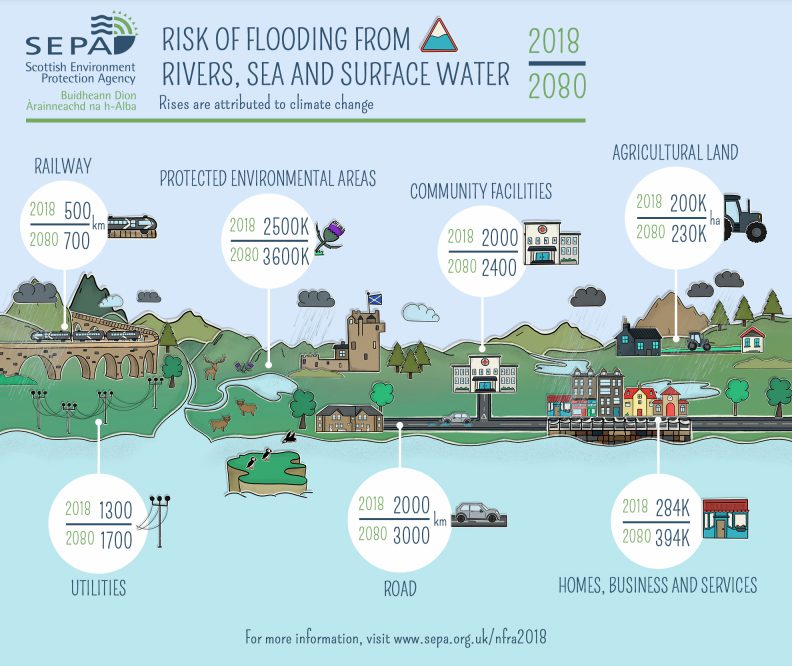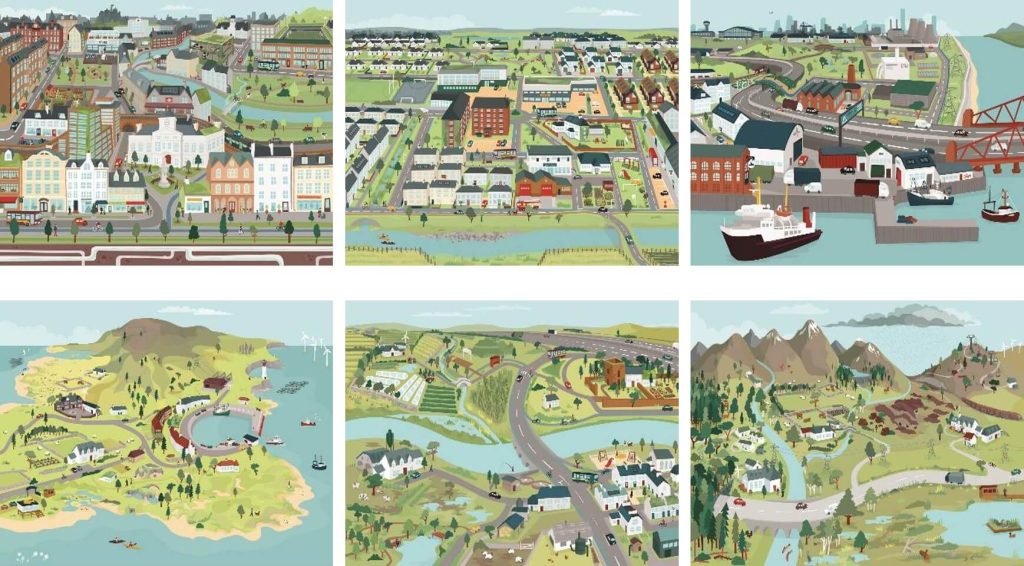Resilient Places
How can our communities, towns and cities be healthy, connected and safe places to be whatever the weather?
The Challenge
The Scottish weather can cause significant problems for homes, businesses and travel. These problems are predicted to get worse as the climate changes, with wilder and wetter weather, more flooding and landslides, but also heatwaves and drought. The businesses and public services we depend on in daily life need to work together to avoid these negative impacts on health and well-being, the economy and our natural environment.
Adapting homes, communities, workplaces and our infrastructure presents a great opportunity to improve where we live and work: For example, homes can be refurbished to be more energy efficient and less prone to condensation, overheating or flooding, reducing costs and increasing health and well-being. Land use is another example where reducing emissions and managing climate impacts can be achieved through the same interventions, for example reducing flood risk and increasing carbon storage through well-managed peatland and forests.
How do we assess and consider the risks and opportunities from climate change as we develop the places we live and work?
Read the Scottish Climate Change Adaptation Programme
Read more about the climate projections for Scotland
Flood Risk Management
Increased frequency and severity of flooding is a key impact of climate change. Reducing flood risk is therefore a key commitment for the Scottish Government.

Source: National Flood Risk Assessment
The Flood Risk Management (Scotland) Act 2009 introduced a more sustainable and modern approach to flood risk management that is better suited to current needs and can accommodate the impacts of climate change.
Read the Living with Flooding action plan
Read the Water-resilient Places policy framework
Read more about SEPA’s work on flooding
Community resilience
Resilient communities are able to respond to and recover from extreme weather and emergencies. Building resilience depends on planning – both in the physical infrastructure and delivery of emergency and health services.
National and local governments, emergency services, road and rail authorities, individual businesses and the public all have their role to play.
For resources to prepare for, respond to, and recover from a range of emergencies visit Ready Scotland’s e-learning platform .
Explore the Climate Ready Places tool :

Buildings and infrastructure
Our buildings, and transport and utilities infrastructure are vital elements in a modern society and economy. Disruption in one location can have significant knock-on effect across a much wider area.
How we plan, build and manage our infrastructure impacts on both greenhouse gas emissions and our ability to reduce and manage the negative impacts of a changing climate. The Scottish Government’s draft Infrastructure Investment Plan sets out three strategic themes:
- Enabling the transition to net zero emissions and environmental sustainability
- Driving inclusive economic growth
- Building resilient and sustainable places
These aims are echoed in the position Scottish Government’s Position Statement for the National Planning Framework 4 which sets out an approach to increase active travel and green infrastructure, using the infrastructure we have for longer rather than building new, and how to stimulate planning and design approaches that create low carbon resilient places.
Read A National Mission with Local Impact – draft infrastructure investment plan 2021‑2022 to 2025‑2026: consultation
Read the Scottish Government’s Position Statement for the National Planning Framework 4
Our Response
The Scottish Government has been at the forefront of adaptation planning, producing one of the first national climate change adaptation plans.
This gives Scotland a good starting point for planning action and tracking how well we are adapting.
- Flooding and water management
- Risk assessment, monitoring and evaluation
- Land use and infrastructure
Flooding and water management
Flooding is already a problem in both rural and urban areas. Research can help planning how we deal with future flooding and how we plan, build and manage our land to reduce the impact of flooding.
Featured Projects
On issues relating to flooding and flood risk we work closely with CREW – Scotland’s Centre of Expertise on Water .
Risk assessment, monitoring and evaluation
Adaptation is a long-term challenge. We support the Scottish Government in assessing the risks from the impacts of climate change across society and the effectiveness of Scotland’s efforts to adapt.
Featured Projects
Land use and infrastructure
We look for practical solutions that deliver carbon savings and contribute to climate resilience.
Featured Projects